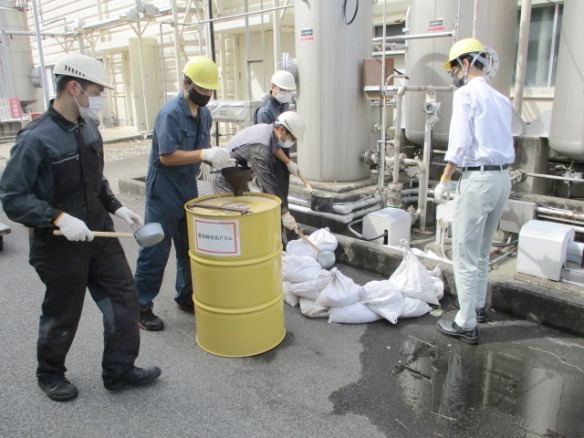Basic Concept
The Nisshinbo Group's Business Conduct Guidelines include Awareness and Concern towards its environmental impact. The Group properly manages hazardous substances, implements measures to prevent leakage in accordance with the laws and regulations of each country, strives to properly manage substances contained in its products, and faithfully realizes a safe and secure society for all people.
【Main measures】
- ① Conducting appropriate control and anti-leakage measures for hazardous materials through ISO 14001 activities in accordance with the laws and regulations of each country
- ② Reducing the use of substances subject to PRTR and reducing the release and transfer of substances subject to PRTR at manufacturing sites
- ③ In the Precision Instruments business, switching of cleaning agents used in cleaning processes to products not covered by PRTR
- ④ Provide emergency response training for chemical substance leaks
* PRTR substances: Substances subject to the Pollutant Release and Transfer Register (PRTR) system pursuant to the "Act on the Confirmation, etc. of Release Amounts of Specific Chemical Substances in the Environment and Promotion of Improvements to the Management Thereof" and reports of their amounts of release and transfer must be filed.
Please refer to "Promotion System" in "Environmental Management" for the promotion system.
Specific Initiatives of The Nisshinbo Group
Assessment of the 5th Three-Year Environmental Targets (to be achieved by FY2024)
The Nisshinbo Group established the 5th Three-Year Environmental Goals (5th Sustainability Promotion Plan) with the fiscal year ending FY2024 as the target year, setting the promotion of environmental management as a priority activity and establishing the following KPIs to promote the reduction of the volume of PRTR substances emissions per unit of sales.
Reduction of the volume of PRTR substances emissions per unit of sales: Reduce by 30% or more compared to FY2014.
As a result of systematic measures to manage reductions through the PDCA cycle, the Group's Reduction of the volume of PRTR substances emissions per unit of sales in FY2024 was reduced by 41% compared to FY2014. The main reason for the reduction was a decrease in PRTR substances emissions following the transfer of the TMD Group, which was a consolidated subsidiary.
Assessment of the 6th Three-Year Environmental Targets (to be achieved by FY2027)
In the 6th Three-Year Environmental Targets (6th Sustainability Promotion Plan) with FY2027 as the target year, we raised the KPI values based on the initiatives of the 5th term as milestones for achieving the medium-term environmental targets.
Reduction of the volume of PRTR substances emissions per unit of sales: Reduce by 30% or more compared to FY2014.
Please refer to "Environmental Management" for details regarding of the "3-Year Environmental Targets."
Please refer to "Sustainability Promotion Plan and KPIs" for details regarding of the "Sustainability Promotion Plan."
Volume of Chemical Substances Handled
In FY2024, The volume of substances subject to PRTR handled by the Nisshinbo Group was 1,506 t, down 37% year-on-year (YoY). The transfer of the TMD Group, which was a subsidiary engaged in the Automobile Brakes business, resulted in a decrease in the volume of antimony and the handled compounds.
The main substances handled among the PRTR-listed substances are isocyanates, which are raw materials for spandex elastomers, and hexamethylenetetramine, which is a raw material for brake friction materials.
The Chemicals business accounted for 55% of the overall volume of chemical substances handled by the Group.
Trends in the Volume of PRTR Substances Handled
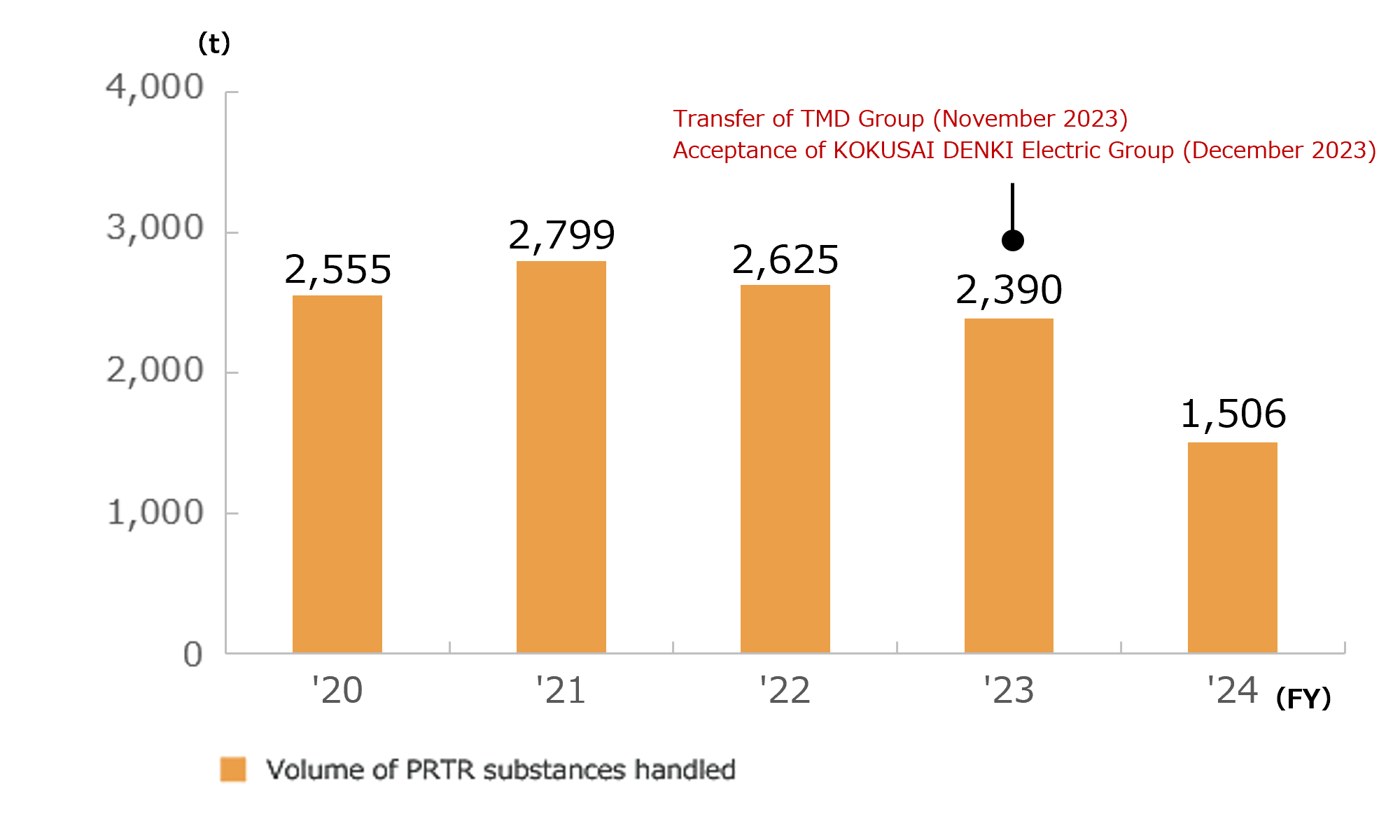
*1 Nisshinbo Holdings Inc. (the "Company") excluded TMD Group, which was a consolidated subsidiary, from the scope of consolidation, due to its transfer, which took place on November 30, 2023. As a result, data for TMD Group is included in the aggregation up to November 2023.
*2 On December 27, 2023, the Company included KOKUSAI DENKI Electric Group within its scope of consolidation, and data for the group is included from FY2024.
*3 On November 28, 2024, the Company included ARGONICS GmbH and ARGONAV GmbH within the scope of consolidation as subsidiaries in the Wireless and Communications business. However, data for these companies is not included in the FY2024 data.
Volume of PRTR Substances Handled by Business
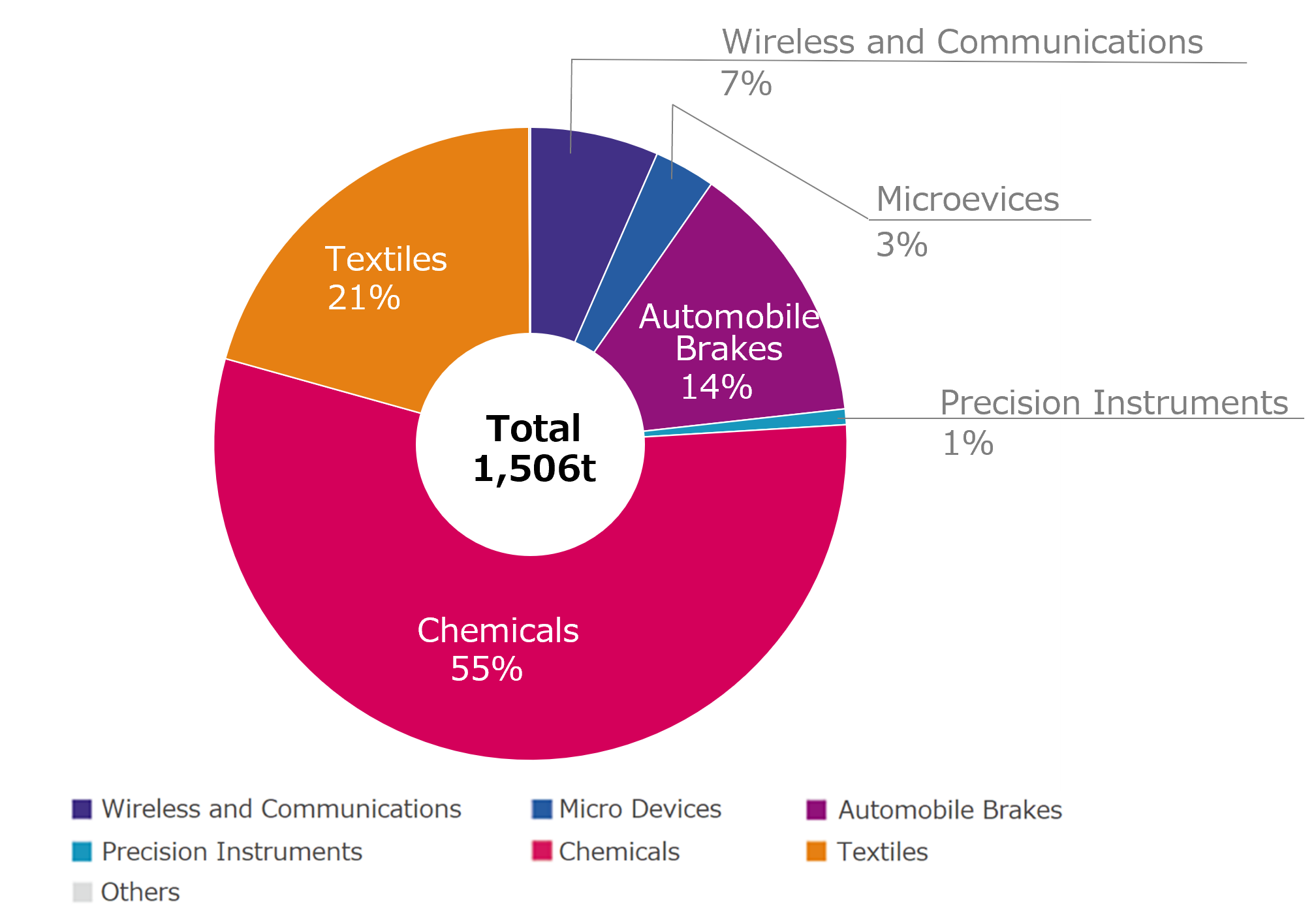
Volume of Chemical Substance Emissions
In FY2024, the Nisshinbo Group's volume of PRTR substance emissions totaled 20.8 t, down 12% year on year. Volume of PRTR substance emissions per unit of sales was 0.042 kg/million yen, down 6% year on year. The main reason for the reduction was a decrease in PRTR substances emissions following the transfer of the TMD Group, which was a consolidated subsidiary.
Trends in Volume of PRTR Substance Emissions and Volume of PRTR Substance Emissions per Sales
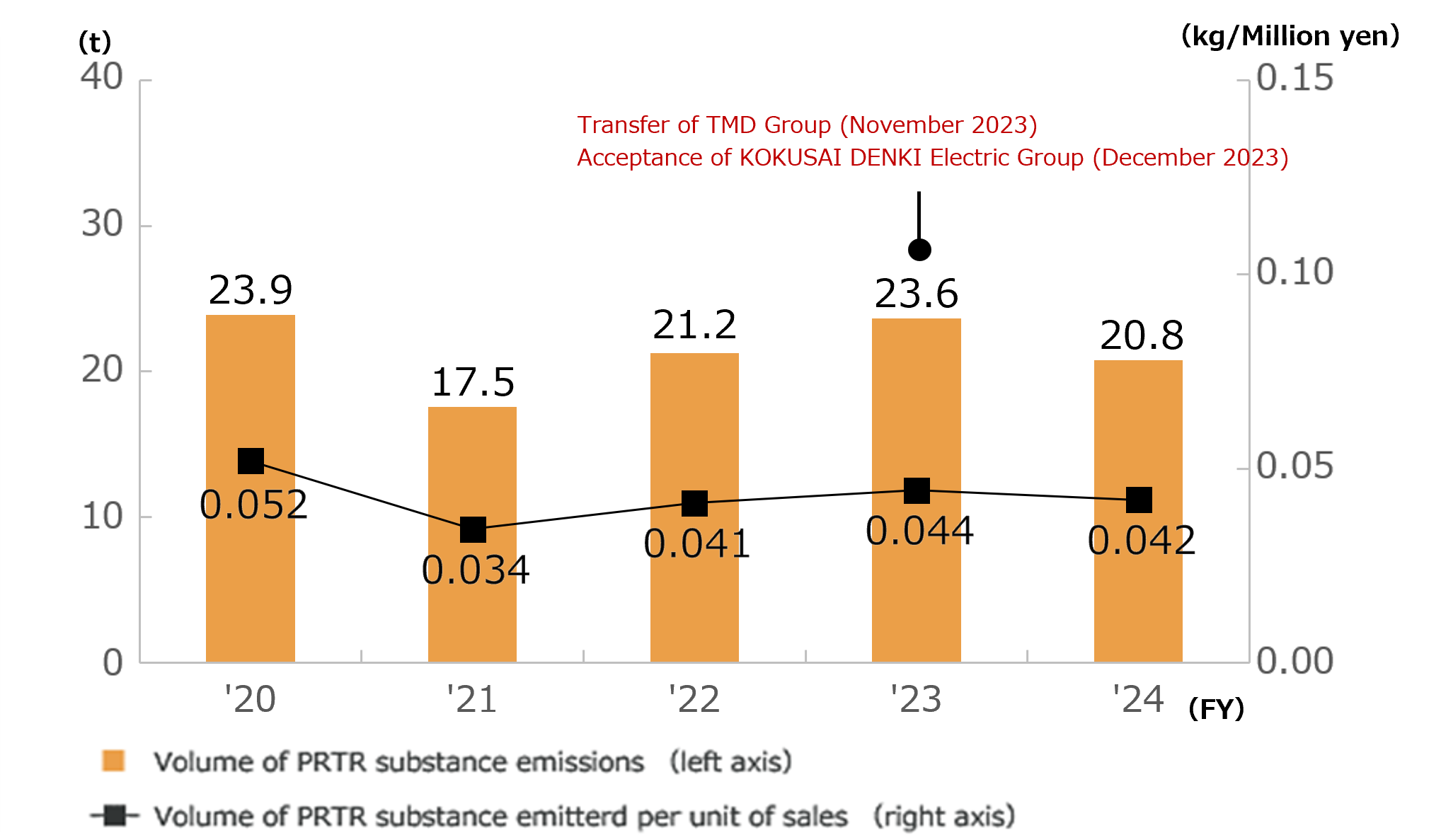
*1 Nisshinbo Holdings Inc. (the "Company") excluded TMD Group, which was a consolidated subsidiary, from the scope of consolidation, due to its transfer, which took place on November 30, 2023. As a result, data for TMD Group is included in the aggregation up to November 2023.
*2 On December 27, 2023, the Company included KOKUSAI DENKI Electric Group within its scope of consolidation, and data for the group is included from FY2024.
*3 On November 28, 2024, the Company included ARGONICS GmbH and ARGONAV GmbH within the scope of consolidation as subsidiaries in the Wireless and Communications business. However, data for these companies is not included in the FY2024 data.
Emission Breakdown by Chemical Substance
| Chemical Substance | Discharge Amount(t) | Ratio |
|---|---|---|
| Toluene | 6.9 | 33.4% |
| Xylene | 2.8 | 13.6% |
| Ethylbenzene | 2.0 | 9.8% |
| Trimethylbenzene | 1.4 | 6.9% |
| 1-Bromopropane | 1.4 | 6.8% |
| N-methyl-2-pyrrolidone | 1.0 | 4.7% |
| Others | 5.1 | 24.8% |
Toluene accounted for the highest proportion of emitted chemical substances, at 33% of the total.
By business, the proportion of the Precision Instruments business releasing toluene, xylene, and ethylbenzene was 58% of the total.
Volume of PRTR Substances Emitted by Business
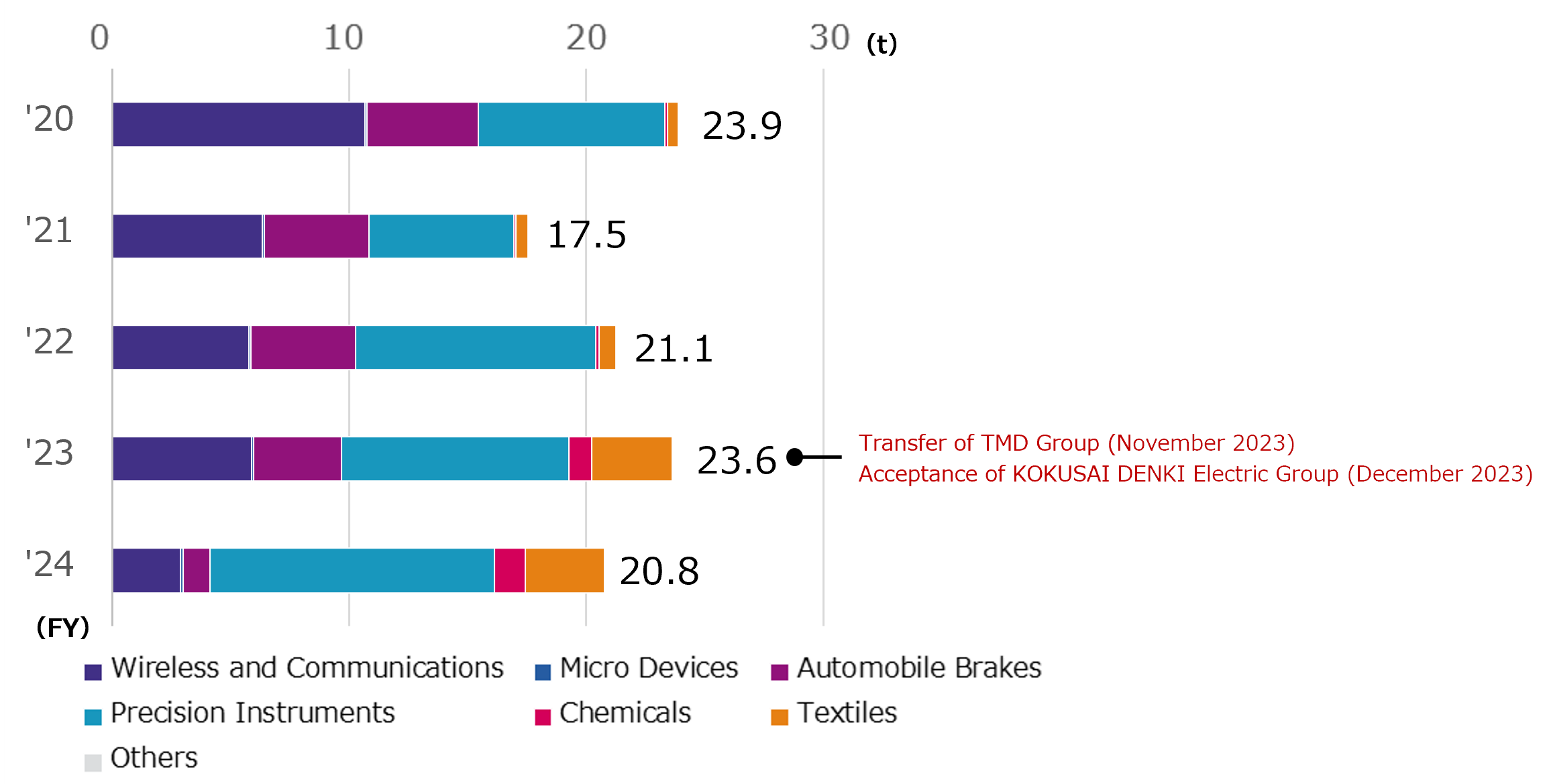
*1 Nisshinbo Holdings Inc. (the "Company") excluded TMD Group, which was a consolidated subsidiary, from the scope of consolidation, due to its transfer, which took place on November 30, 2023. As a result, data for TMD Group is included in the aggregation up to November 2023.
*2 On December 27, 2023, the Company included KOKUSAI DENKI Electric Group within its scope of consolidation, and data for the group is included from FY2024.
*3 On November 28, 2024, the Company included ARGONICS GmbH and ARGONAV GmbH within the scope of consolidation as subsidiaries in the Wireless and Communications business. However, data for these companies is not included in the FY2024 data.
Purification of Wastewater
In FY2024, the Nisshinbo Group's volume of suspended substances (SSs) emissions per unit of sales totaled 0.09 kg/million yen, down 55% year on year. The volume of CODs* emissions per unit of sales was 0.25 kg/million yen, down 9% year on year. The main factors in the decrease were the transfer of the TMD Group and the reduction in production of the Micro Devices business.
* Chemical Oxygen Demand (COD): An index of water contamination expressed as the volume of oxygen chemically required or chemically consumed
Trends in Amount of SSs Emissions per Unit of Sales and Amount of CODs Emissions per Unit
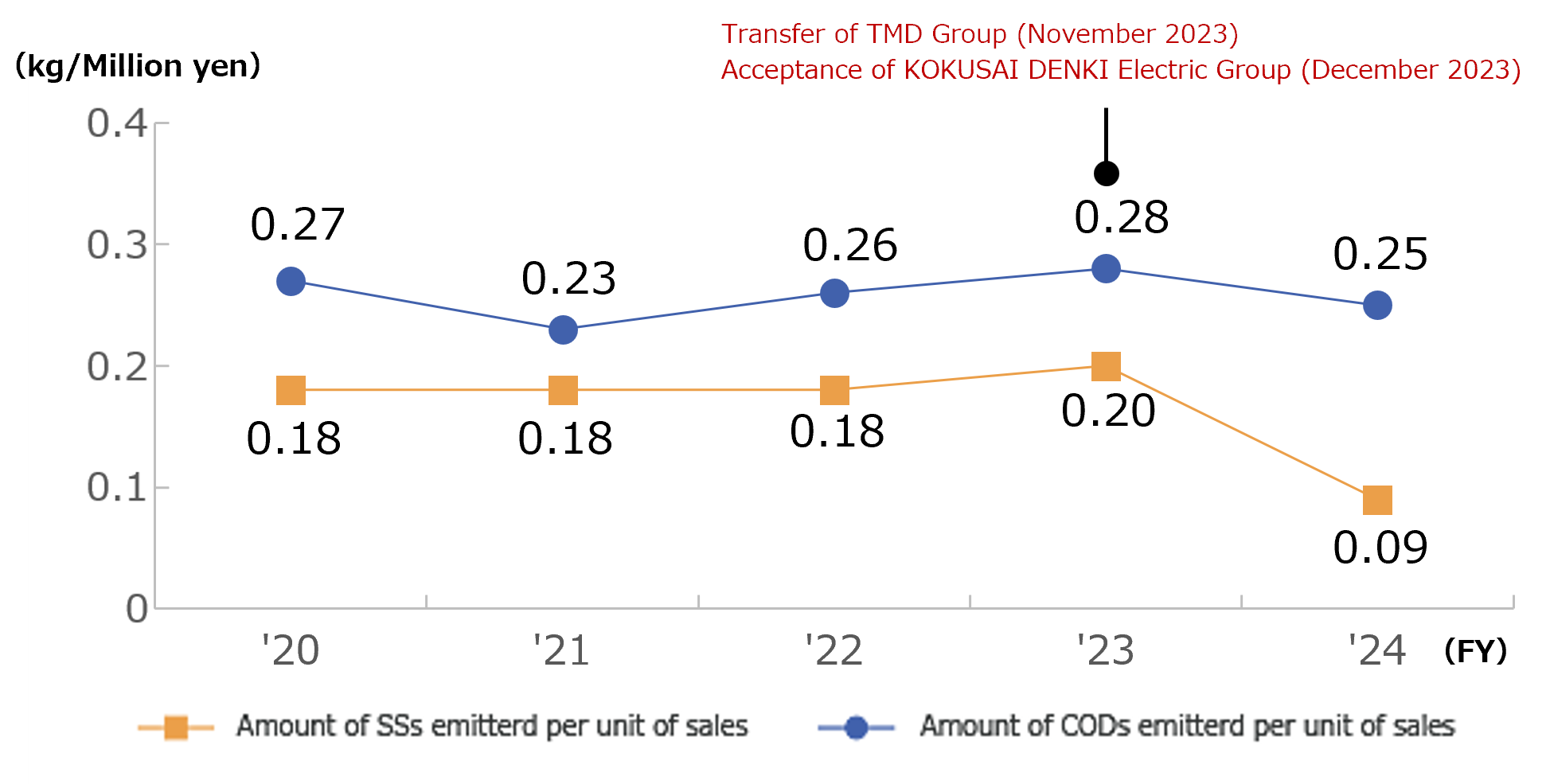
*1 Nisshinbo Holdings Inc. (the "Company") excluded TMD Group, which was a consolidated subsidiary, from the scope of consolidation, due to its transfer, which took place on November 30, 2023. As a result, data for TMD Group is included in the aggregation up to November 2023.
*2 On December 27, 2023, the Company included KOKUSAI DENKI Electric Group within its scope of consolidation, and data for the group is included from FY2024.
*3 On November 28, 2024, the Company included ARGONICS GmbH and ARGONAV GmbH within the scope of consolidation as subsidiaries in the Wireless and Communications business. However, data for these companies is not included in the FY2024 data.
Atmospheric Releases
In FY2024, the Nisshinbo Group's sulfuric oxides (SOx) emissions per unit of sales was 0.07 kg/million yen, down 1% YoY. Nitrogen oxides (NOx) emissions per unit of sales was 0.07 kg/million yen, down 16% YoY. Volatile organic compounds (VOCs*) emissions per unit of sales was 0.11 kg/million yen, down 5% YoY. Soot and dust emissions per unit of sales was 0.03 kg/million yen, unchanged down 16% YoY. The transfer of the TMD Group, which was a subsidiary in the Automobile Brakes business, resulted in an overall reduction of emissions into the atmosphere.
PT. Nikawa Textile Industry (Indonesia), the Textiles business, stopped using coal boilers in November 2021 and eliminated the use of coal, resulting in a significant decrease in SOx and NOx emissions for the Group from FY2022.
* Volatile Organic Compounds (VOCs): Volatile organic compounds, such as toluene
Trends in Amount of SOx Emissions per Unit of Sales, Amount of NOx Emissions per Unit of Sales, Amount of VOCs Emissions per Unit of Sales and , Amount of soot and dust Emissions per Unit of Sales
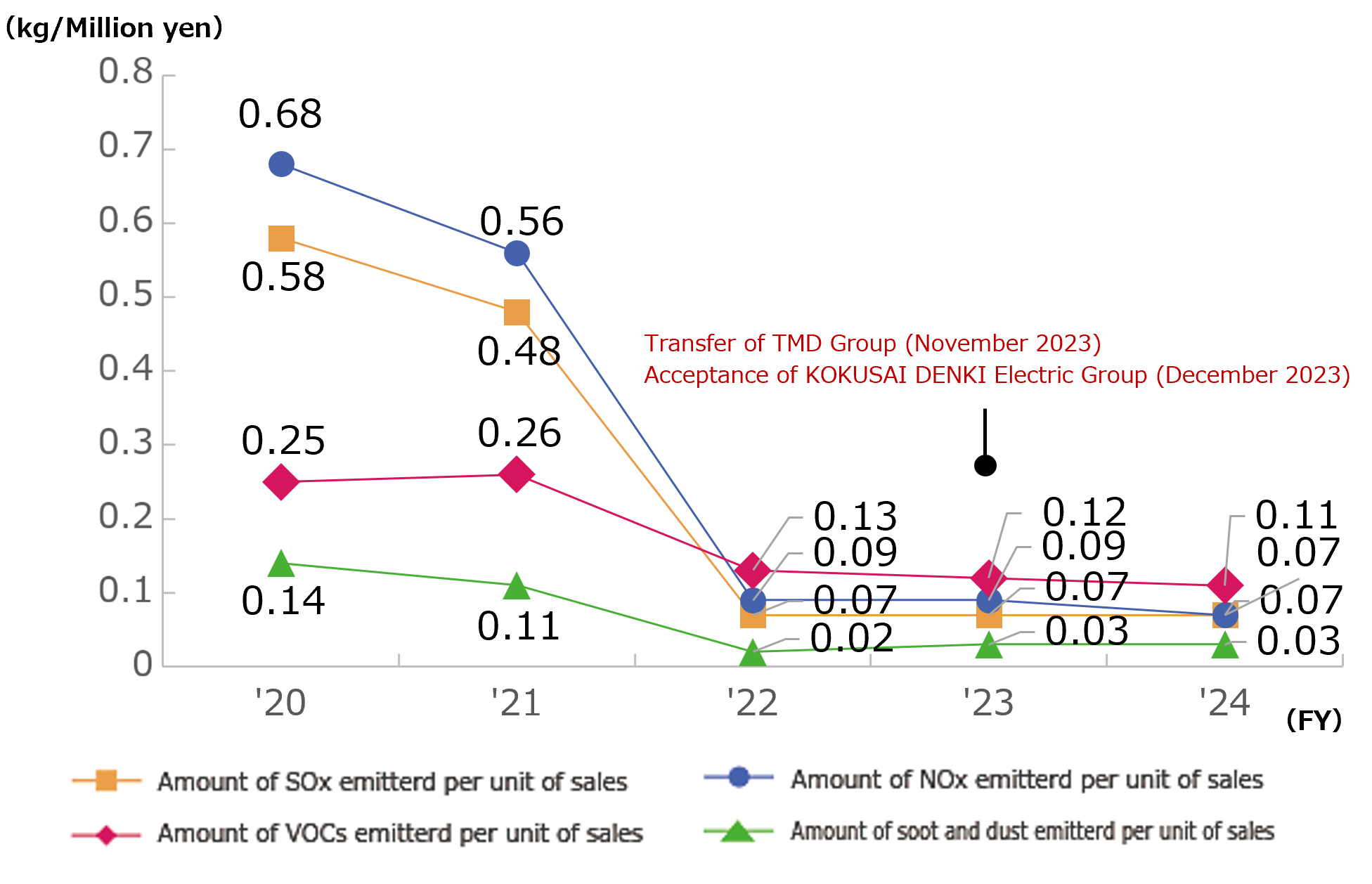
*1 Nisshinbo Holdings Inc. (the "Company") excluded TMD Group, which was a consolidated subsidiary, from the scope of consolidation, due to its transfer, which took place on November 30, 2023. As a result, data for TMD Group is included in the aggregation up to November 2023.
*2 On December 27, 2023, the Company included KOKUSAI DENKI Electric Group within its scope of consolidation, and data for the group is included from FY2024.
*3 On November 28, 2024, the Company included ARGONICS GmbH and ARGONAV GmbH within the scope of consolidation as subsidiaries in the Wireless and Communications business. However, data for these companies is not included in the FY2024 data.
Specific Activities of the Group Companies
Emergency response training for a chemical spill
Every year, Nisshinbo Holdings Inc. conducts emergency response drills for chemical substance leaks as part of its disaster prevention training program jointly with the Toke Plant of Nisshinbo Chemical Inc.
In FY2024, drills were conducted in November on the assumption of a chemical leak due to the toppling of a one-dozen can of methanol, a chemical stored indoors at the Toke Plant, after a large-scale earthquake (intensity 6+).
Through training for a chemical leak linked to emergency drills, Nisshinbo Holdings Inc. will continue to maintain a system in which all employees who handle chemical substances can take the appropriate action in the event of an emergency.
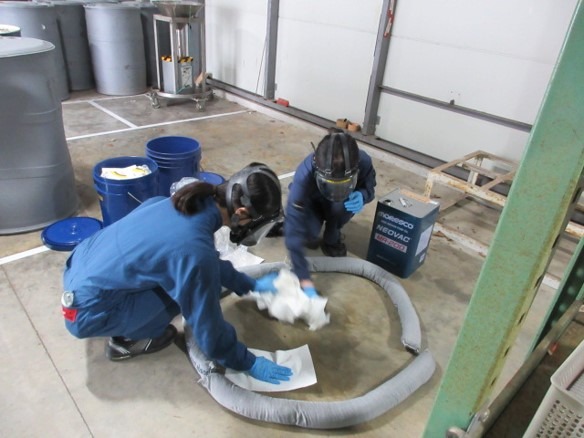
Control of chemicals handled
To prevent accidents, health hazards and environmental pollution caused by chemical substances, JRC Tokki Co., Ltd. uses the results of risk assessments to implement measures to reduce exposure, such as shortening working hours and considering alternatives. In addition, the management officer, who wears protective equipment, plays a central role in selecting appropriate protective equipment according to the working environment and conditions in order to ensure the safety and security of the workers.
With regard to the chemical substances hand, led by the company, JRC Tokki Co., Ltd. regularly works with suppliers to consider changing to substances with lower hazard risks (e.g. explosives, flammability, carcinogenicity and acute toxicity).
So far, alternatives have been introduced for cleaning agents that do not contain specified chemical substances and paints that are not PRTR-compliant. JRC Tokki Co., Ltd. will continue to strive for the proper handling of chemical substances in accordance with laws and regulations.
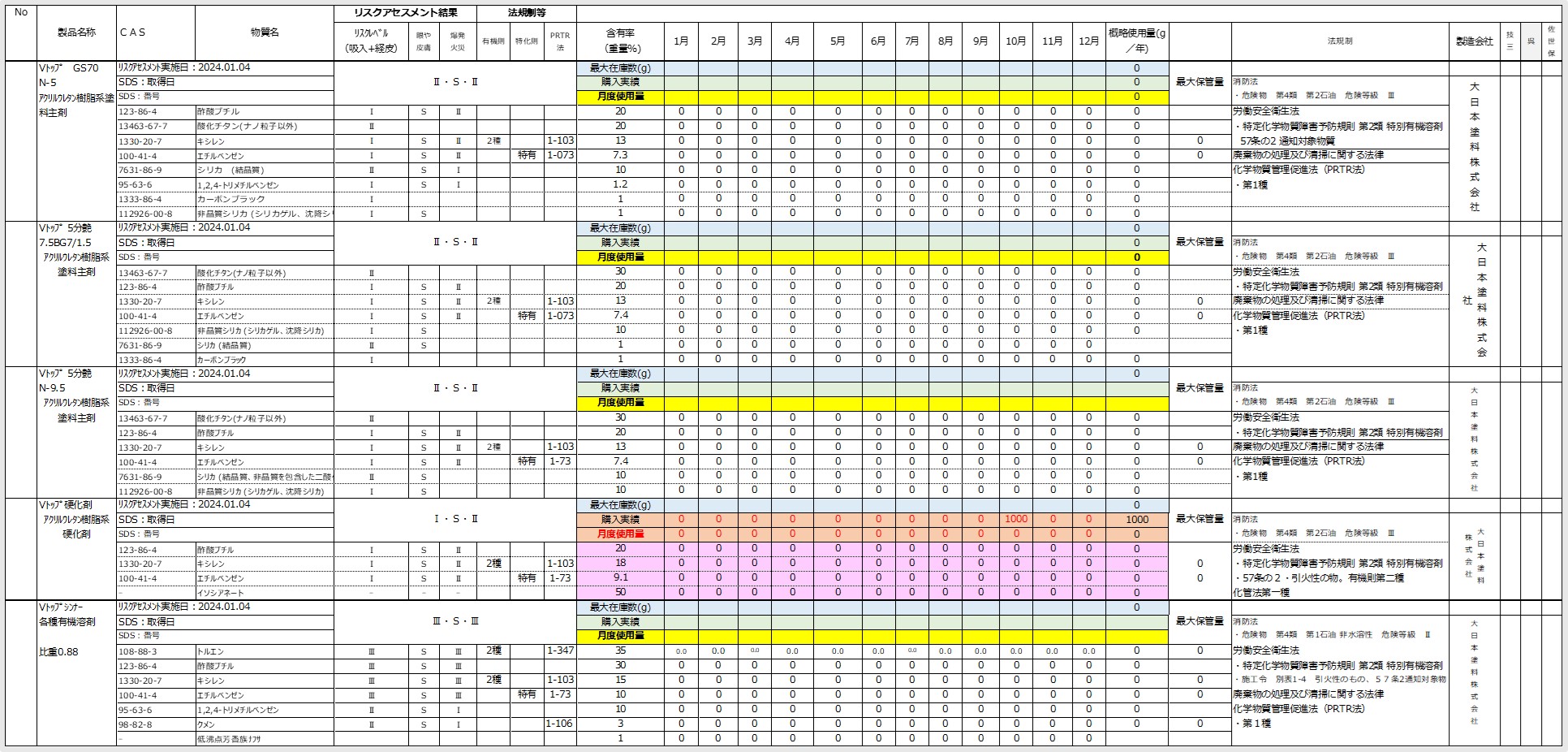
Chemical Spill Disaster Drill
Nagano Japan Radio Co., Ltd. provided the following training in anticipation of chemical substances flowing into rivers.
- ① The company installed a shutoff plate in anticipation of abnormal pH values in the discharge water due to equipment malfunction or failure.
- ② To prevent river water from flowing in during typhoons and other rainfall, and to prevent large amounts of rainwater from entering drainage treatment facilities, the company installed waterproof sheets and stacked water bags.
This training was a very meaningful opportunity to reaffirm the importance of the company's responsibilities and of protecting stakeholders, as well as continuing business activities.
The company will continue to comply with regulations and will strive to conduct business under the necessary monitoring and management systems in order to continue business activities.
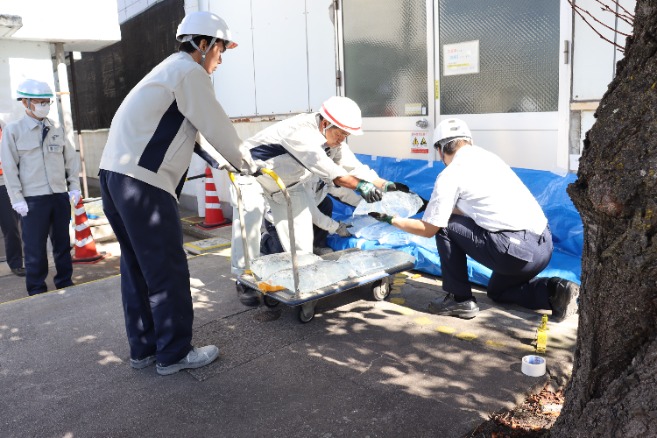
Emergency Drill Assuming Chemical Spill
The Tsurunumadai and Sendai Plants of GOYO ELECTRONICS CO., LTD. conduct annual emergency drills designed to minimize the environmental impact of a chemical spill caused by natural disasters or accidents.
At the Sendai Plant, personnel received training to prevent kerosene from flowing into storm drains if a plastic container filled with kerosene were accidentally knocked over while being transported from a hazardous materials storage facility.
On the day of training, two employees who had previous training experience guided two employees who were participating in the training for the first time. They provided the training with reference to the procedure manual. Since a quick response is necessary in the event of an actual spill, the training made the personnel realize the importance of receiving regular training and acquiring the necessary skills to respond promptly in the event of an emergency.
The company will continue to provide regular training to ensure that everyone is familiar with the proper procedures and is prepared to respond to emergencies.
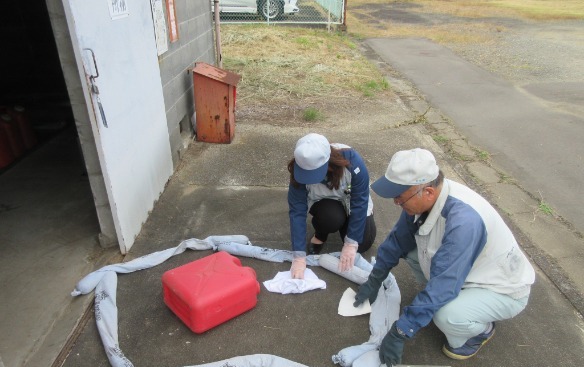
Reflow Furnace Cleaning Solution Changed to Environmentally Friendly Water-Based Cleaning Agent
GOYO ELECTRONICS CO., LTD. used isopropyl alcohol (IPA) as a cleaning agent to remove flux adhering to the reflow furnaces (heating furnaces) used for soldering electronic components to printed circuit boards. The company conducted a review of its equipment cleaning agents from the perspective of preventing air pollution caused by VOC* emissions during hand wiping and immersion cleaning, as well as preventing organic solvent poisoning. As a result, the company switched to an environmentally friendly water-based flux cleaning agent starting in August 2024. This change resulted in the company reducing IPA emissions by 0.1 tons compared to the previous year.
Going forward, the company will switch to environmentally friendly water-based flux cleaning agents as a replacement for the IPA used to clean flux adhering to chains and transport claws in automatic soldering equipment, similar to the replacement of cleaning agents used to clean flux adhering to reflow furnaces. The company will also work to reduce VOC emissions and improve the working environment.
* Volatile Organic Compounds (VOCs): Volatile organic compounds, such as toluene
Conducting Emergency Response Training for Hydrochloric Acid Leaks
Nisshinbo Micro Devices AT Co., Ltd. provided environmental emergency response training in collaboration with the Facilities Department and Kyushu Bldg. Services Co., Ltd., which is responsible for facility maintenance and monitoring, to address potential leakage accidents (such as heavy oil, chemicals, and acid/alkali wastewater) that may occur in utility facilities. In 2024, the company provided emergency response training based on the scenario where the liquid level gauge of the hydrochloric acid tank used in the ion exchange resin regeneration solution for the pure water production system malfunctioned, which resulted in a hydrochloric acid leak.
Hydrochloric acid generates gas, so personnel must wear a gas mask equipped with an acid-absorbing filter, chemical-resistant coveralls, chemical-resistant gloves, and protective footwear. In the event of a leak, measures must be prioritized to prevent the substance from escaping outside the facility by blocking nearby drains with sandbags to prevent the substance from flowing into them. After that, workers wearing protective gear will perform the leak stopping operations (closing valves). When closing the valve, water is sprayed from the windward side using a hose to suppress the release of gas. After practical training, classroom instruction on the dangers of chemicals is also provided to ensure that all relevant personnel have the correct knowledge.
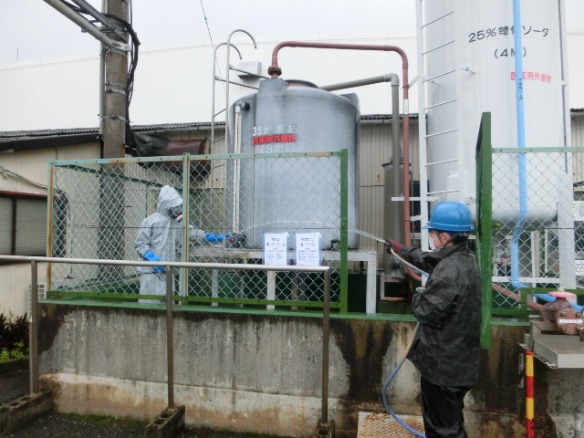
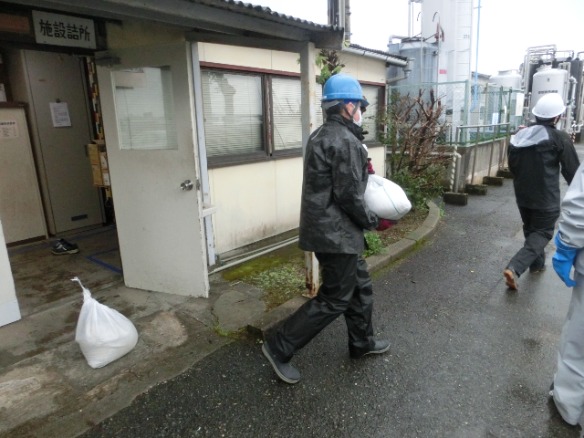
Chemicals education provided
Nisshinbo Saeron (Changshu) Automotive Co., Ltd in China provides annual chemical substance training to prevent environmental risks caused by chemical substance spills.
The aim of this training is to make sure that employees fully understand the correct handling of chemical substances and the related hazards so that they can carry out their work safely. The training covers a wide range of topics, including basic knowledge of chemical substances, hazard assessment, how to read SDS (safety data sheets), the meaning of labels, and instructions on how to respond in an emergency.
In addition, hazardous waste and hazardous material leakage training is provided every April to ensure that all relevant personnel can respond appropriately to emergency situations.
These drills simulate real-life scenarios, review response procedures in the event of a leakage incident, and train participants to respond quickly and appropriately. This helps to raise employee safety awareness and minimize environmental risks.
The company also carries out regular risk assessments on the handling of chemicals to identify potential hazards in advance and to take action. This prevents environmental pollution from chemical spills and leaks and ensures the health and safety of employees.
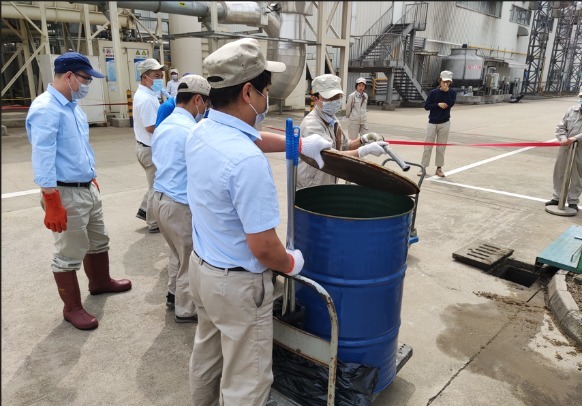
Chemical Risk Assessment
Nisshinbo Mechatronics Inc. conducts risk assessments on all new chemical substances before use.
When handling new chemical substances, an assessment must be made using a chemical substance risk assessment sheet. This assessment is reviewed by the Risk Assessment Committee and approved by the health and safety manager, chemical substance management officer, and safety and health committee chair before the substance can be used in the workplace. During this process, depending on the level of harm to workers and the impact on the environment, on-site inspections may be conducted, and instructions for corrective actions or measures may be issued.
In addition, every year, all business divisions check the latest SDS (product safety data sheets) and, if the information has been revised, conduct risk assessments and evaluate hazards as necessary.
Through these activities, the company is promoting the creation of a safe and hygienic workplace environment.
Conducting Chemical Spill Response Drills
PT. Standard Indonesia Industry provides regular B3 substance leak response training every year. B3 substances refer to hazardous substances and dangerous chemicals that are harmful to human health and have a negative impact on the environment. All companies that use B3 substances must fully understand the B3 substance leak procedures and ensure that employees will handle them appropriately.
In November 2024, approximately 15 people, including representatives from the Production, Production Management, and Quality Assurance departments, as well as 3B substance handlers, participated in training provided under the guidance of a hazardous materials management supervisor. The training covered the handling of B3 substance spills and outdoor drainage leaks.
This was an opportunity to reaffirm the importance of confirming and practicing procedures for responding to hazardous material leaks. In their daily operations, company personnel strive to minimize all risks by properly managing hazardous materials and wearing protective equipment.
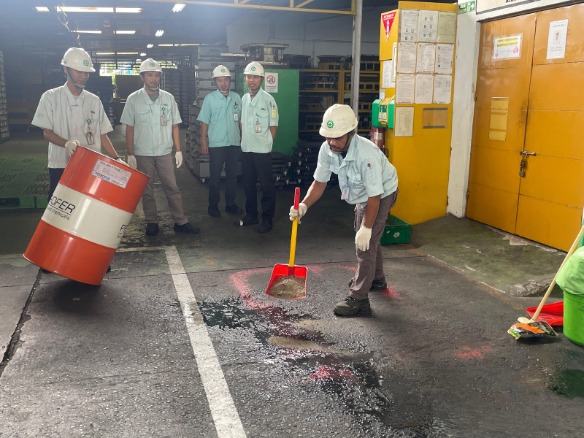
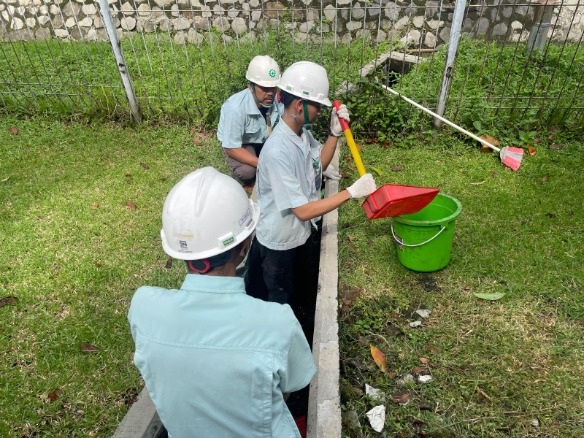
Reduction in the Amount of PRTR-Listed Cleaning Agents Used
Nisshinbo Chemical Inc. Tokushima Plant manufactures resin additives called CARBODILITETM. Since the company uses PRTR*-listed substances as the raw materials for its products and as cleaning solvents for manufacturing equipment, the company set a target for the FY2024 to reduce emissions of PRTR-listed substances used in the cleaning process as part of its continuous improvement activities.
In post-production cleaning of manufacturing equipment, the company repeatedly verified the amount of cleaning solvent used and the condition of the manufacturing equipment after cleaning, and as a result, the company reduced the amount used per cleaning by 20% compared to the previous method.
As a result of implementation beginning in April 2024, the company achieved a reduction of 0.119 t per year in PRTR substance emissions in FY2024. The company will continue to promote environmentally friendly business operations.
Accelerating Global Sales Expansion of Water-Based Crosslinking Agents
Globally, paints, coatings, adhesives, and other products that use organic solvent-based resins, such as toluene, are subject to stricter chemical substance management regulations and VOC (volatile organic compound) regulations because of concerns about environmental issues and occupational safety and health. As a result, there is a growing trend toward replacing these products with water-based resins, which are safer and more environmentally friendly. Furthermore, in the manufacturing processes that use water-based resins, the development of environmentally friendly technologies aimed at reducing processing temperatures and shortening processing times in the drying process is accelerating with the goal of reducing carbon dioxide emissions and energy consumption.
The CARBODILITETM water-based crosslinking agent from Nisshinbo Chemical Inc. enables the realization of high performance that could not be achieved with water-based resins alone. Additionally, by leveraging the low-temperature reactivity and quick-drying characteristics of its products, the company is making a significant contribution to the development of new technologies and the widespread adoption of products aimed at addressing global environmental issues.
The company will continue to actively promote the expansion of water-based crosslinking agents in the global market and contribute to solving global environmental issues.
Oil Spill Prevention Training
Nisshinbo Textile Inc. Tokushima Plant provided chemical substance leakage prevention training in November 2024.
The plant manufactures polyurethane products and uses many chemical substances as raw materials. In order to receive and store these new raw materials, there are outdoor tank facilities, but the plant is located adjacent to the Imagire River, a tributary of the Yoshino River, which means there is a risk that chemical leaks could cause a major environmental problem. Therefore, liquid barriers, oil-water separators, and shutoff gates are installed around the chemical tank equipment and drainage routes to prevent leakage to the outside.
At this time, the company conducted drills for two scenarios: one involving a magnitude 6.5 earthquake that caused cracks in outdoor liquid containment walls, resulting in chemical leaks, and another involving a fire in the indoor facilities. In the chemical spill scenario, the company confirmed the procedure for recovering chemicals by surrounding cracks in the liquid barrier with sandbags and using absorbent sheets and dippers.
Preventing chemical spills is essential, but it is also important to be prepared for emergencies. During the training, the company reviewed each person's roles and procedures and reconfirmed how the company would work together to respond to emergencies.
